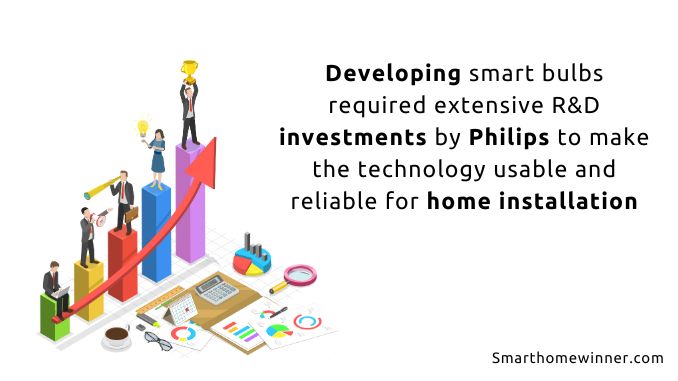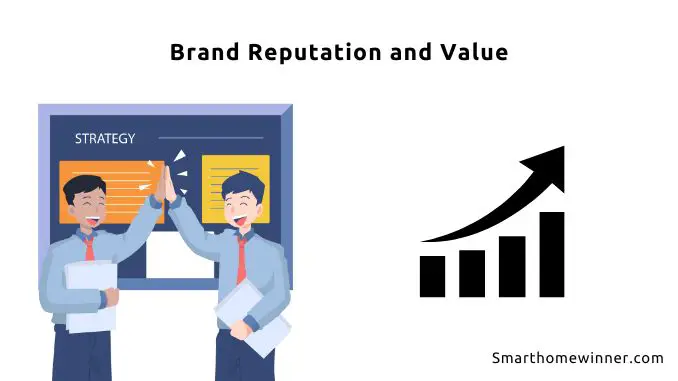Philips Hue is one of the most popular and capable smart lighting systems available, allowing users advanced control over lighting in their homes. However, Hue bulbs, fixtures, and accessories come at a premium price compared to budget smart bulbs. Several factors contribute to the high costs of the Philips Hue ecosystem.
What are the key factors contributing to the high costs of the Philips Hue ecosystem?
The high-end costs for users are primarily attributed to Philips’ investment. In particular, key factors contribute to this are the following:
- Research and Developments Costs
- Advanced Features and Capabilities
- Brand Reputation and Value
- Ongoing Support and Updates
- Pricing Power in the Market
1. Research and Development Costs

Philips Hue first launched in 2012 as one of the first mainstream smart lighting options targeted at regular consumers. Developing smart bulbs required extensive R&D investments by Philips to make the technology usable and reliable for home installation.
Creating smart bulbs that can connect to WiFi, be controlled by smartphones, change colors, work with voice assistants, and integrate with other systems was a complex endeavor. Being the first move into smart lighting meant Philips took on significant upfront financial risk in developing the proprietary technology that powers Hue.
These large initial R&D expenditures to develop smart lighting technology get passed on to consumers through the retail pricing of Hue bulbs and accessories. Since they weren’t building off existing smart lighting tech, Philips had to recoup those early R&D investments, contributing to higher costs than subsequent smart bulb offerings.
2. Advanced Features and Capabilities
Hue commands premium pricing because its products offer more advanced features and capabilities than budget competitors. This includes:
- Millions of customizable color options
- Syncing with entertainment systems
- Sophisticated scheduling and automation
- High color accuracy and light quality
- Compatibility with Alexa, Google Home, Apple HomeKit
- Away from home control
- Integration with smart home platforms
Developing these complex features requires more advanced hardware and engineering built into every Hue bulb and bridge, driving up manufacturing costs. The computing power and components for color accuracy, home entertainment syncing, remote access, and app integration are very expensive compared to basic standalone bulbs.
Consumers are paying a premium for the most fully-featured and capable smart lighting experience that more basic bulbs can’t match. You get what you pay for in terms of Hue’s deeper integration and customization versus cheaper bulbs with just basic on/off/dimming functions.
3. Brand Reputation and Value

Philips has been a lighting brand for over 130 years, spending decades building a reputation for high quality and innovation. This gives them strong brand recognition and trust in the lighting category they leverage for the Hue line.
Many consumers are willing to pay more for the Philips name even compared to cheaper smart bulbs that may have similar core technology. Hue is viewed as a premium brand in smart lighting that delivers a polished experience from an established company.
While smart lighting is still an emerging category, Philips aims to be the go-to brand for high-end solutions. The Hue name also conveys seamless integration and reliability that buyers aren’t as sure they’ll get from newer, unproven smart home brands.
4. Ongoing Support and Updates
Another factor that adds to long-term costs of owning Hue products is that Philips continues providing support, updates, and new features over time. When you buy a basic smart bulb, there is little ongoing evolution after purchase.
But Philips frequently issues firmware updates to Hue bulbs, adds new app features and integrations, and keeps the system current. This requires continuous backend and engineering work passed onto buyers through the upfront pricing.
Post-purchase support and improvements ensure Hue retains value and stays competitive. It costs extra compared to smart bulbs that work the same years later as the day you bought them. The superior long-term experience of Hue justified charging more.
5. Pricing Power in the Market
A final contributor to Hue’s high prices is simple market positioning. As the leading brand in smart lighting with high awareness and loyalty, Philips Hue can leverage pricing power in the category.
Even with competing products available, Hue’s reputation, features, and post-purchase support mean Philips can charge premium prices and retain sales. When you become the dominant player in a technology segment, you gain leeway to price higher than competitors while retaining customers.
Philips understands that many consumers will pay extra for the Hue name, capabilities, and ecosystem. And with their brand strength, the company can get away with the high price tags that budget bulbs can’t.
Conclusion
Philips Hue smart lighting carries premium pricing due to high R&D costs as an early innovator, unmatched features and integrations, strong brand reputation, ongoing updates requiring support, and market clout. While the system is expensive, Hue delivers exceptional capabilities not found in budget bulbs. For most buyers, the price is justified by the quality, polish, and integration of Hue smart lighting.